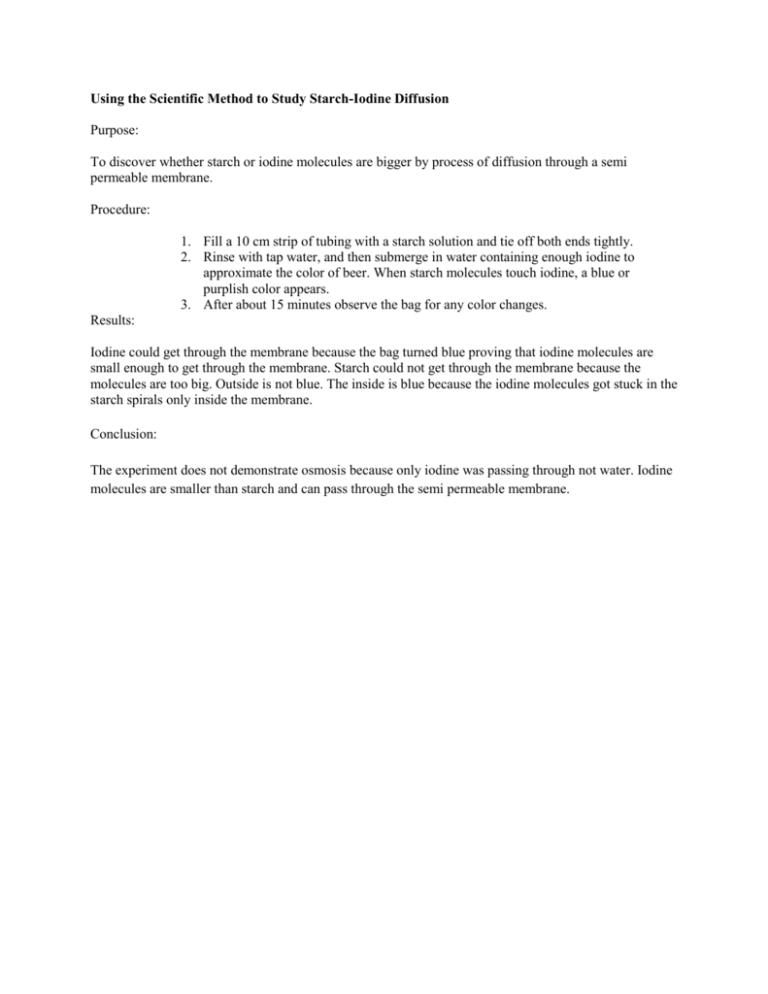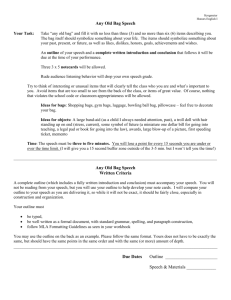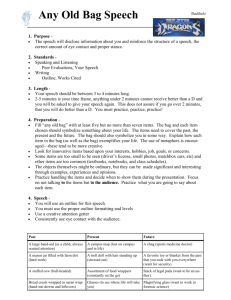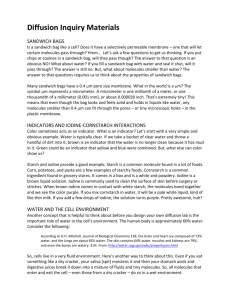Using the Scientific Method to Study Starch
advertisement

Using the Scientific Method to Study Starch-Iodine Diffusion Purpose: To discover whether starch or iodine molecules are bigger by process of diffusion through a semi permeable membrane. Procedure: 1. Fill a 10 cm strip of tubing with a starch solution and tie off both ends tightly. 2. Rinse with tap water, and then submerge in water containing enough iodine to approximate the color of beer. When starch molecules touch iodine, a blue or purplish color appears. 3. After about 15 minutes observe the bag for any color changes. Results: Iodine could get through the membrane because the bag turned blue proving that iodine molecules are small enough to get through the membrane. Starch could not get through the membrane because the molecules are too big. Outside is not blue. The inside is blue because the iodine molecules got stuck in the starch spirals only inside the membrane. Conclusion: The experiment does not demonstrate osmosis because only iodine was passing through not water. Iodine molecules are smaller than starch and can pass through the semi permeable membrane. Diffusion of a Gas in a Gas Purpose: To see how the molecular weight of a compound affects the rate at which it diffuses through the air. Materials Ring stand and glass tube (apparatus) Hydrochloric acid Ammonium hydroxide 2 pieces of absorbent cotton gloves Procedure: 1. Set up the apparatus with the ring stand and glass tube under the fume hood. 2. Put on gloves. 3. Saturate a piece of absorbing cotton in ammonium hydroxide (NH4OH) and another piece of cotton in hydrochloric acid (HCl). 4. Place pieces of cotton simultaneously into the glass tube on both ends and wait for reaction. Results: The Ammonium hydroxide and the hydrochloric acid reacted to form ammonium chloride (NH4Cl, a cloudy, white precipitate) and water. NH4OH + HCl → NH4Cl + H2O Trend/Conclusion: Because the molecular weight of the ammonium hydroxide is 35 and the hydrochloric acid is 36 the reaction occurs closer to the hydrochloric acid because the ammonium hydroxide moves faster in the diffusion. Test for Chloride Ions and Starch Purpose: To determine if a solution contains either chloride ions or starch. Materials: 6 test tubes Solutions to test: NaCl, starch, distilled water Silver Nitrate Iodine Procedure: 1. Obtain 6 test tubes and number them 1-6. 2. Fill each test tube (5ml) with NaCl (first 2), starch (second 2) and distilled water (last two). 3. To tubes 1, 3, and 5 add 2-3 drops of AgNO3, mix, and observe. 4. To tubes 2, 4, and 6 add 2-3 drops of iodine, mix and observe. 5. Record observations. Results: Tube 1 should have a reaction because NaCl is composed of the Na+ ion and the Cl- which reacts with silver nitrate. Tube 4 has a reaction because iodine reacts with starch molecules. Effect of Solute Concentration on the Rate of Osmosis Purpose: To measure the effect on osmosis of the varying tonicity of the fluid within this differentially permeable membrane. Materials: 5 dialysis bags 20, 40, 60 % sucrose solution Tap water 5 beakers Procedure: 1. Obtain five dialysis bags and tie each bag on one end by folding the end over and tying with a thread. 2. Fill the bags with bag 1 having 15 ml of tap water, bag 2 having 15 ml of 20% sucrose solution, bag 3 having 15 ml of 40% sucrose solution, bag 4 having 60% sucrose solution, and bag 5 having 15 ml of tap water. 3. As each bag is filled remove the air by squeezing the bottom end of the bag to bring the liquid to the top. 4. Press the sides of the bag together so air does not reenter and fold the end of the bag over about 5 cm and tie securely with thread. 5. Wipe each bag dry and weigh each separately to the nearest 0.5g. Record the weights. 6. Place bags 1, 2, 3, and 4 in separate beakers of water, and place bag 5 in a beaker of 60% sucrose solution. 7. At 15 minute intervals remove the bags, wipe off excess water, and weigh each bag separately. 8. Record observations for every 15 minutes up to about 75 minutes. Results: The bag 1 in the tap water had no change, bag 2 with 20% sucrose filled with a little water and got heavier, bag 3 with 40% sucrose filled with more water than bag 2, bag 4 with 60% sucrose filled with more water than bag 3, and bag 5 filled with tap water lost weight. Trend/Conclusion: When the bag 1 was placed in an isotonic solution it did not change as molecules just flowed in and out evenly. When bags 2, 3, and 4 were placed in a hypotonic solution they inflated to weigh more as the water molecules diffused into the bags. When bag 5 was placed in a hypertonic solution it deflated as the water molecules diffused out of the bag to a lower concentration outside the bag. Diffusion of a Liquid in a Solid Purpose: To determine the relationship between the rate of diffusion of a liquid in a solid and its molecular weight. Materials: Petri dish with agar No. 5 cork borer 1 M(molar concentration) of NaCl (Sodium Chloride), AgNO3 (Silver Nitrate), Potassium Bromide (KBr), and Potassium Ferricyanide (K3Fe[CN]6). Procedure: 1. 2. 3. 4. Result: Pour agar into a Petri dish to a depth of 6 mm. Punch holes by using a No. 5 cork borer each 15mm from each other. Add several drops of each solution to separate holes. Do not allow them to overflow. Cover the Petri dish, set aside, and wait for molecules to diffuse through the agar. NaCl was the fastest of the anions, AgNO3 was second, KBr was third, and K3Fe[CN]6 was the slowest Trend/Conclusion: The lighter the weight of the anion, the faster the molecules diffuse. Lysis and Crenation (Hemolysis) Purpose: To show how a hypotonic solution, hypertonic solution, and an isotonic solution affect a erythrocyte. Procedure: 1. Obtain three clean slides and, with a wax pencil, mark one 5%, one .85%, and one 0% (distilled water). Set up three microscopes. 2. Place a drop of the appropriate saline solution (NaCl) on each slide. 3. Obtain some blood from the instructor (e.g. cow’s blood). 4. Deposit a small drop of blood beside the drop of saline. 5. Add a cover slip to each slide immediately, raising and lowering the cover slip a couple of times to mix the blood and the saline. Add more of the proper solution at the edge of the cover slip if necessary. 6. Choose an area where the cells are thinly distributed and observe under high power. The differences are best compared if three microscopes are used at once, side by side. Trend/Results/Conclusion: The RBC in the hypotonic solution (0%) hemolyzed, the RBC in the hypertonic solution (5 %) crenated, and the RBC in the isotonic solution (.85 %) was normal.









